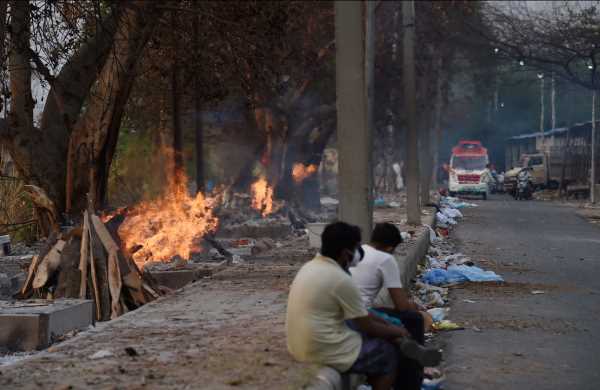An analysis of Budget speeches made by finance ministers over 75 years also offers a glimpse of how low on the priority list healthcare has featured for the political class and policy-makers, which is a significant reason for the current situation, says Nivedita Mookerji.
Shortage of ICU beds, oxygen, ventilators, vaccines, doctors, nurses and crematorium space in India has dominated headlines around the world in the past few weeks with Covid-19 cases surging beyond control and the government failing to deliver.
Yes, election rallies, Kumbh Mela, blatant flouting of social distancing and mask protocols coupled with a messy vaccination process are said to be responsible for the health crisis of colossal proportions that India is facing today.
But an analysis of Budget speeches made by finance ministers over 75 years also offers a glimpse of how low on the priority list healthcare has featured for the political class and policy-makers, which is a significant reason for the current situation.
Not only has health allocation in terms of percentage of gross domestic product (GDP) remained at a low single digit, many Budget speeches have skipped health altogether, while others have dealt with it only symbolically by, say, increasing cigarette prices and modifying family planning schemes.
In fact, “health” did not find a single mention at all in some 27 Union Budget speeches.
And, in 19 Budget speeches, health was referred to only in passing, along with other social sector matters.
Till 1971, hardly any finance minister elaborated on the subject of healthcare.
The list includes R K Shanmukham Chetty, C D Deshmukh, T T Krishnamachari, Jawaharlal Nehru (additional charge of FM when he was the prime minister), Morarji Desai and Indira Gandhi (additional charge as FM when she was the PM).
Y B Chavan in 1971-72 broke his predecessors’ record with four mentions of “health”.
In a departure, he announced a duty of 10 paise per kg on maida processed by roller flour mills in the organised sector to meet the government’s child and family nutrition expenses.
However, in two subsequent Budgets, Chavan refrained from mentioning health.
Yashwant Sinha, finance minister in the Atal Bihari Vajpayee government, had in his 1999-2000 Budget speech announced a technology mission for vaccines.
In a conversation with Business Standard, Sinha said he was not sure how the vaccine mission had progressed, but pointed out that inadequate spending on healthcare was part of the reason for a crisis like this.
“India has not created healthcare infrastructure,” he said.
During the first wave, the country somehow coped, he added, and then “we were caught napping”.
Holding the “highest level in the government” responsible for the “complacency”, Sinha said he was disappointed also with the bureaucracy as it had failed to respond to the ongoing disaster.
On not spending enough on healthcare infrastructure, Sinha said, “It’s because of lack of resources.”
According to the former Bharatiya Janata Party (BJP) minister, who is now with the Trinamool Congress, every finance minister tries to strike a balance in the Budget.
“There’s been a significant dependence on the private sector in healthcare and in the process, smaller towns and rural areas have got left out,” he said.
Even as the Indian health sector has witnessed some important developments, these have been few, according to officials.
For instance, the Bhore Committee recommendation just before Independence was a blueprint for healthcare.
Setting up of the All India Institute of Medical Sciences (AIIMS), New Delhi, in 1956 was yet another landmark development.
Then in 2003, Sushma Swaraj as health minister initiated the expansion of AIIMS to smaller towns.
The National Rural Health Mission (NRHM) and more recently Ayushman Bharat health insurance programme were among other notable steps.
K Srinath Reddy, president of the Public Health Foundation of India and former head of the Department of Cardiology at AIIMS, said healthcare had never been a priority in political decision making unlike some other areas of economic activities.
“For several years, health was not seen as an economically productive investment and was considered more as a necessary social sector support,” he pointed out.
Among others, Manmohan Singh as finance minister in 1996-97 highlighted the social aspect of healthcare in his Budget speech: “As the private sector has expanded vigorously into many areas which were earlier reserved for the State, the focus of State activity and the deployment of public resources is now being concentrated on meeting the needs of the poor and on the social sectors such as health, education and rural infrastructure where the market economy alone cannot bring benefits rapidly.”
In the middle of the pandemic, Finance Minister Nirmala Sitharaman in her latest Budget clubbed healthcare with water and sanitation while announcing a 137 per cent increase in allocation.
Asked about the low spending on healthcare, K M Chandrasekhar, cabinet secretary from 2007 to 2011, said, “The fact is that a large chunk of our people do not pay tax… and then there are leakages everywhere.”
Also, money is diverted to other areas depending on predilections of particular leaders and focus on populism, he said.
According to Chandrasekhar, the abolition of planning has made the situation much worse, turning the government economic policy whimsical.
Chandrasekhar said the Central Vista should not be a priority in the current time.
“If this crisis leads to a rejig of our finances and restoration of well-considered planned development and economic policy formulation, it would be a good thing for India.”
Source: Read Full Article


